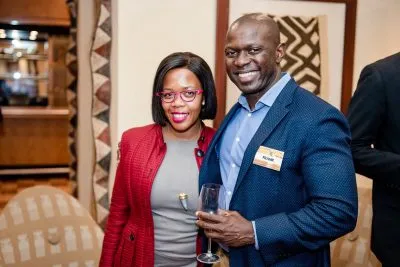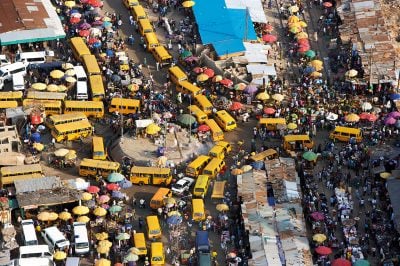Wide-reaching economic research conclusively reveals the high return on investing in opportunities for women in Africa.
The UN for example reports that women typically reinvest up to 90% of their income in the education, health and nutrition of their family and community. This compares with just 35% of such reinvestment by men and illustrates clearly that investment in women’s businesses helps transform African economies and its societies.
SMEs now account for over 80% of employment across Africa, where they have created a flourishing new middle class and fuelled strong demand for new goods and services.
According to the World Economic Forum (WEF), women make up 58% of Africa’s self-employed population, contributing around 13% of Africa’s total GDP.
Regionally, sub-Saharan Africa has the highest rate of entrepreneurship in the world, with approximately 42% of the region’s non-agricultural labour force classified as self-employed or employers. The Mastercard Index of Women Entrepreneurs meanwhile reveals Botswana, South Africa and Ghana have among the highest global proportion of women entrepreneurs.
These positive data can only rise as a growing number of government strategies support women entrepreneurs and female-led startups in Africa through targeted policies, including gender-responsive budgeting and through the use of the African Continental Free Trade Agreement (AfCFTA).
The UN estimates that some 70% of informal cross-border trade in Africa is now conducted by women traders. Furthermore, the AfCFTA, which was launched in 2021, gave rise to the hopes of many female entrepreneurs that this free trade area, with a market of 1.2bn people, will boost their businesses and reduce endemic poverty.
The UN reports that the gender pay gap in sub-Saharan Africa is 30% compared with 24% globally. According to the International Finance Corporation (IFC) – which runs an initiative with the European Commission to help boost online commerce opportunities for women in emerging markets – there is a need to close the gap between the earnings of male and female merchants. It predicts this would increase Africa’s market value by at least $14.5bn.
Numerous initiatives are now addressing the gender pay gap. UN Women, for example, has pledged to continue efforts to raise awareness and promote policy change to narrow and close the gender pay gap and ensure women and girls have equal rights to their male counterparts.
While the gender pay gap between men and women has been steadily declining in recent years, the funding gap for female entrepreneurs in sub-Saharan Africa is still $42bn.
The WEF reported that in 2022, 67.8% of Sub-Saharan Africa’s gender gap had closed compared with 63.4% in North Africa. While lower than North America, which showed a closure of the gender gap of 76.9%, both North and sub-Saharan Africa had closed the gap by a greater proportion than South Asia at 62.4%.
Encouragingly, according to the WEF Global Gender Gap Index, Rwanda has closed its gap by 81.1% and Namibia by 80.7%. This gap is universally expected to improve as access to finance further liberates women’s entrepreneurial capacity in Africa.
Read more about Africa’s women entrepreneurs
- Women-led companies outperform African stock exchanges
- ‘The tiny, tiny, number of black women who have received venture funding is shameful!’
- Women in the boardroom: more than a number
- Gender lens investing takes centre stage
Access to credit
The fashion industry in sub-Saharan Africa is dominated by women, whose small businesses connect a vibrant cotton-textile garment industry that alone produces $31bn annually.
However, without access to financing, women-owned enterprises and entrepreneurs struggle to tap into higher-value areas of the fashion industry, the number of users of which is expected to amount to nearly 400m by 2027.
According to the World Bank, establishing an appropriate legal framework is a critical entry point to overcoming women’s lack of financial inclusion. Laws to eliminate gender discrimination in access to banking services in Africa are pivotal to this movement.
In 2021, no fewer than six sub-Saharan countries still had laws forbidding women from opening a bank account without their husband’s consent and amendment of such legislation is actively being encouraged.
The IMF identified further opportunities to close the ongoing gender gaps in access to finance, advising African decision-makers to take practical steps to address demand-side factors such as the financial illiteracy of women and girls.
Arming women entrepreneurs with the appropriate financial knowledge and skills will inevitably boost their effective engagement in the credit market, opportunities for which are growing as increasingly, women-led SMEs contribute to the social fabric and infrastructure of African nations in a virtuous circle.
In its report, Access to Finance: Why Aren’t Women Leaning In?, the IMF cites Affirmative Finance Action for Women in Africa (AFAWA), which offers capacity building services for women entrepreneurs and advocates for reforms to support women-owned businesses, and reveals that last year, G7 leaders pledged $251m to back the programme, which is aimed at unlocking $3bn in Africa’s private sector funding.
E-commerce growth for women
Unsurprisingly, Africa has until recently lagged behind the developed world in digital infrastructure. This is fast changing. The goal of the Africa Union’s Digital Transformation Strategy is for digital inclusion for every African citizen by 2030 – up from just 22% of the population in 2017.
This rapid growth in access to the Internet throughout the continent will inevitably unveil vast new opportunities for women startups and for self-employed women.
Further digital investment across the economies of Africa will help enable growth in economic opportunities for women across the continent.
For example, Kenya’s M-Pesa is a mobile money service run by Vodafone and Kenyan telecommunications provider Safaricom that provides payment and financial services, even if a customer has no access to a bank account. By 2022, access had steadily risen to 52.4m customers.
Revenue in the women’s fashion sector is forecast to grow by 12.5% year-on-year until 2027, reaching $13.3bn. Meanwhile, according to the World Bank, the proportion of women in Africa with access to a bank account has more than doubled in the past 12 years.
This is adding traction to the AfDB’s offer of a range of fundraising facilities that form part of its initiative to boost access to finance for women in Africa. These include an individual loan guarantee of up to $2.5m and assistance for partner financial institutions to support them in lending to SMEs and thus help increase their SME portfolio. In the latter case, the AfDB shares the loan cost equally with the bank.
In January, AFAWA announced it had reached the $1bn investment milestone in women entrepreneurs in Africa.
As well as focusing on raising loan finance, in 2015 the AfDB launched its flagship initiative, Fashionomics, to raise the profile of African fashion and textiles on the international stage, investing in high-growth sectors with the potential to promote women empowerment and create 25m jobs by 2025.
Sub-Saharan fashion industries alone are valued at over $30bn. Fashionomics links women designers, buyers and suppliers and connects them to financial services providers and mentors, in the process significantly raising the total value of the sector.
A surge in developments since the formation of AFAWA clearly show its investment ambitions to be bang on the money.
Want to continue reading? Subscribe today.
You've read all your free articles for this month! Subscribe now to enjoy full access to our content.
Digital Monthly
£8.00 / month
Receive full unlimited access to our articles, opinions, podcasts and more.
Digital Yearly
£70.00 / year
Our best value offer - save £26 and gain access to all of our digital content for an entire year!
 Sign in with Google
Sign in with Google 



